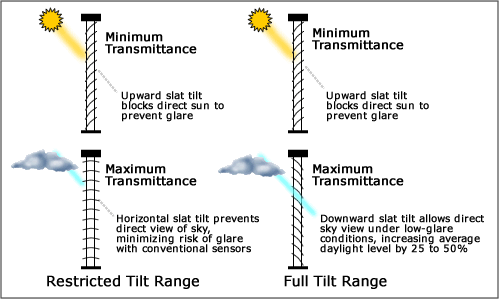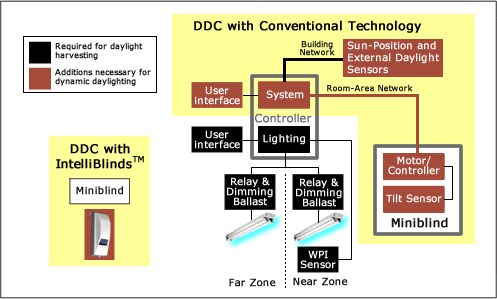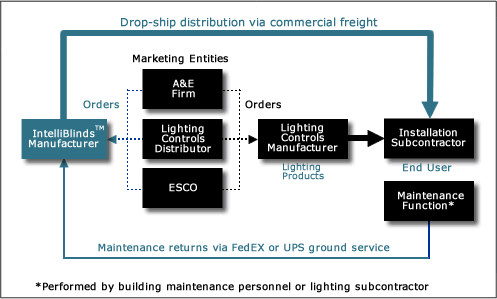Advantages Over Conventional Technology
The First and Only Market-Friendly Dynamic Daylighting Technology
When the IntelliBlinds™ Model D is installed near a daylight-harvesting lighting system, the two form a high-performance dynamic daylighting system. IntelliBlinds™ automatically maximzes glare-free daylight, while the lighting control harvests that daylight by dimming or switching the lamps to maintain the desired total illumination. Typical energy savings are more than doubled relative to daylight harvesting alone, and uncertainties due to dependence on manual shading adjustments are virtually eliminated.
Dynamic daylighting isn't new; systems that combine automated shading and daylight harvesting were first demonstrated almost two decades ago, and such systems have been commercially available for years. Yet, the penetration of conventional dynamic daylighting technology in the non-residential retrofit market remains negligible. The reason is that conventional dynamic daylighting systems are too expensive, too difficult to distribute, and too difficult to install for mainstream retrofit use.
The IntelliBlinds™ Model D was developed from the ground up to overcome all of those disadvantages.
Slashes Payback Period for Dynamic Daylighting by Two-Thirds
The key cost-effectiveness metric in the market for energy saving retrofits is the payback period. In the U.S., the median payback period for energy saving retrofits in commercial office buildings is 3 years, and technologies with paybacks significantly longer than that are effectively locked-out of the retrofit market.
Exessive payback period has been the primary obstacle to adoption of conventional dynamic daylighting technology. Conventional DDC technology is so expensive that including it in a daylighting project increases the payback period, stretching it to more than twice the upper limit of what mainstream buyers are willing to accept. So conventional DDC technology is used in just a few high-profile "statement" buildings where cost-effectiveness isn't an issue.
On the other hand, the IntelliBlinds™ Model D is actually less expensive than the typical lighting control, so including it in a daylighting project reduces the payback period while more than doubling the savings. The median payback with IntelliBlinds™ in a typical retrofit is only about half that of daylight harvesting alone, and only about one-third that of daylight harvesting with conventional DDC technology:

The IntelliBlinds™ Model D shortens the payback period in two ways:
- It admits more daylight under low-glare conditions than conventional dynamic daylighting systems, increasing average savings by 34%.
- More importantly, it slashes retrofit cost by 70%.
Increases Energy Savings by One-Third
Because the wages of people who work in office buildings are far greater than the energy costs, avoiding any compromise in the occupants' comfort and productivity is even more important for an energy saving technology than maximizing the savings. So it's critical that dynamic daylighting systems avoid any risk of glare or excessive brightness.
Typically, conventional dynamic daylighting systems that use venetian blinds avoid this risk by ensuring that slats are never tilted to allow a direct view of the sky. That's necessary because conventional systems don't directly sense the daylight in the room; rather, they infer the daylight level from the total (daylight plus artificial) interior illuminance, the exterior daylight illuminance, the position of the sun, and the dimming level of the lamps. Due to inevitable inaccuracies in this process, blocking the direct-sky view is the only way to eliminate the risk of glare—but it also reduces the level of useful daylight in low-glare conditions.
In contrast, IntelliBlinds™ directly senses the admitted daylight (independent of any artificial illumination) via its IntelliLux™ DLS sensor. The output of the IntelliLux™ DLS is proportional to the level of diffuse daylight in the sidelit zone, but spikes sharply upward whenever there are glare-inducing conditions anywhere in the room. This allows IntelliBlinds™ to use the full slat-tilt range of its host blind without risk of glare:

Our testing shows that using the whole slat-tilt range, instead of blocking the direct-sky view, increases the average daylight level under low-glare conditions ranges by 25% to 50%.
As another data point, independent research at Lawrence Berkeley National Laboratory (LBNL) indicated that the energy savings from a prototype dynamic daylighting system would increase by 34% if the control protocol were changed to permit a direct sky view (Lee et al. 1998, page 13).
Thus, a daylight-harvesting system that includes IntelliBlinds™ will provide about 34% greater energy savings than a system based on conventional dynamic daylighting technology.
Reduces Cost by Almost Half
In addition to saving more energy, IntelliBlinds™ also costs only one-third as much as conventional DDC technology, reducing the total cost of dynamic daylighting by almost half:

This overall cost reduction is due to six innovations which substantially reduce every aspect of DDC cost:
- IntelliBlinds™ requires no time-consuming commissioning process. IntelliLux™ Sensor technology is self-commissioning, and the only system adjustment—the daylight set-point—is set by the user.
- IntelliBlinds™ needs no interfaces to other systems. IntelliLux™ technology actually discriminates between artificial and natural illumination, giving IntelliBlinds™ all the information it needs to operate completely autonomously.
- IntelliState™ also significantly eases user interface requirements. That, in turn, enables the IntelliTwist™ Wand to serve as the sole user interface, eliminating the need for a separate control panel or IR remote control.
- Because the IntelliLux™ sensor technology can directly sense the amount of daylight admitted by the host blind, IntelliBlinds™ is capable of performing true closed-loop daylight control without any need for remote sensors. In particular, IntelliBlinds™ can adjust its host blind to block direct sun while still admitting diffuse daylight—without expensive, remote sun-position or slat-tilt sensors, as required in conventional blind-based DDC systems.
- IntelliBlinds™ has a motor and drivetrain that's far less expensive than those of conventional motorized blinds, thanks to IntelliDapter™—an external motorization technology that eases size and form-factor constraints and takes advantage of commodity electromechanical components.
- IntelliDapter™ is compatible with virtually all of the wand-actuated blinds currently installed in U.S. non-residential buildings, eliminating the cost of a new miniblind in a typical retrofit application. And unlike conventional retrofit motorization technology, IntelliDapter™ can be installed without removing or modifying the host blind, sigificantly reducing installation labor.
Simpler Architecture Facilitates Distribution
With conventional dynamic daylighting technology, the shading hardware must be interfaced to several other components—including a controller, the lighting ballast, and several sensors—to get the energy saving benefits of Dynamic Daylight Control (DDC). In contrast, thanks to patented IntelliLux™ sensor technology, the IntelliBlinds™ Model D works autonomously. IntelliLux™ can actually discriminate between daylight and artificial light, eliminating the need for any interfaces to the lighting system. And IntelliLux™ also eliminates the need for separate sun-position and external-daylight sensors.
The result, as shown in the block diagram below, is a substantial reduction in the overall complexity of a dynamic daylighting installation:

Installs In Just Minutes
In addition to easing installation of the overall daylighting
system, IntelliBlinds™ itself is easy to install:
no tools are required and there are no complicated
"commissioning"
calibrations or adjustments to make (other than those that may be required by the lighting control).
Physical Installation
With conventional DDC technology, the existing window covering, if any, must be removed and either modified on-site via installation of motorized components, or replaced with a new motorized window covering. On the other hand, IntelliBlinds™ works with any ordinary wand-actuated miniblind, and if a miniblind is already installed—as is the case with the majority of U.S. non-residential windows—then there's no need to replace (or even remove) it.
Physical installation consists of un-clipping the host blind's tilt-control wand, securing IntelliBlinds™ to the headrail via the thumbscrew, snapping the IntelliBlinds™ output shaft to the blind's input shaft, and clipping the blind's tilt-control wand to the IntelliTwist™ shaft. These steps typically require less than ten minutes, without tools or practice.
Wiring
The IntelliBlinds™ Model D uses low-voltage DC power that can be supplied by either a plug-in AC adapter or a solar-charged battery supply. The solar-powered variant is completely self-contained, and requires no wiring whatsoever—but it costs more than the AC adapter, and the design requires some further development. Therefore, the current baseline design uses the AC adapter (however, we expect the solar-powered variant, when fully developed, may be the preferred choice for many applications).
When powered by the AC adapter, IntelliBlinds™ requires a low-voltage DC power cord. The cord can be either a conventional stranded-pair cord or self-adhesive, paper-thin flat wiring. The conventional cord costs less, but the flat wiring can be completely concealed. The baseline design uses the conventional cord, partly for cost reasons and partly because focus groups show that the conventional cord isn't excessively obtrusive*.
Installation of the cord takes just a few minutes, facilitated by a design feature that is the subject of an in-process patent application.
Set-Up
After installation, the IntelliBlinds™ Model D requires only four simple steps before it's ready for high-performance dynamic daylight control:
- IntelliBlinds™ is trained to recognize the "lights off" condition: the room lights are turned "off" and the IntelliTwist™ Wand is tugged downward and released.
- IntelliBlinds™ is trained to recognize the "lights on" condition. Then the room lights are turned "on" (and set to minimum brightness, if the lighting system has a dimmer) and the IntelliTwist™ Wand is tapped upward and released.
- The first tilt travel limit is set. The
IntelliTwist™ Wand is twisted counterclockwise until the
slats reach their maximum tilt, and then released. Then:
- If the indoor edges of the slats are tilted upward, the Wand is tapped upward and held until the system "beeps".
- If the indoor edges of the slats are tilted downward, the Wand is tugged downward and held until the system beeps.
- The second tilt travel limit is set. Step 3 is repeated with the Wand twisted clockwise instead of counterclockwise.
These steps typically take less than four minutes, even for someone performing them for the first time. And because the IntelliLux™ sensor can discriminate between artificial and natural illumination, set-up can be performed regardless of the exterior daylight level.
Can Be Distributed Independently of Lighting Control
Many of the distribution difficulties of conventional dynamic daylighting systems stem from a single problem: with conventional technology, the shading and lighting portions of a dynamic daylighting system have to "talk" to each other. Since there aren't yet any standardized protocols for dynamic daylighting, the only solution is to distribute the shading and lighting equipment together as an integrated system.
On the other hand, the IntelliBlinds™ Model D works with any daylight-harvesting lighting system and any miniblind, regardless of design or manufacture—eliminating the need for IntelliBlinds™ distributors to carry shading or lighting systems at all.
Complements—Rather than Competes with—Established Products
There are already many different daylight-harvesting lighting controls on the market, as well as many different computerized Energy Management Systems (EMS). Integrated dynamic daylighting technology duplicates some of the functionality of these existing products*. Thus, integrated dynamic daylighting technology effectively competes with products already in the distribution pipeline, making it substantially less appealing to would-be distributors.
But the IntelliBlinds™ Model D competes with nothing else on the market. No other DDC technology is even remotely cost-effective for retrofit applications, so it won't face direct competition. And because it works with all daylight-harvesting lighting controls, there's no risk of incompatibilities (and therefore indirect competition) with the lighting controls carried by would-be distributors.
On the contrary, IntelliBlinds™ complements existing products because it provides a new way to save energy that can't be cost-effectively saved by any other means. Obviously, it works synergistically with daylight-harvesting lighting controls, but it also strengthens the value proposition for at least two other established products:
- Because the IntelliBlinds™ Model D automatically adjusts its host blind to reduce loads on a building's HVAC system when the lamps are switched "off", it works synergistically with occupancy sensing light switches to provide an additional mechanism for saving energy.
- Low-e window films and glazings save energy because they make daylight "cooler", reducing solar heating loads on the HVAC system. But the technology doesn't reduce visible light, so it doesn't eliminate the need for shading—and its benefit is reduced with over-shaded windows, because a closed blind reflects both heat and light back out the window. IntelliBlinds™ eliminates over-shading, so it increases the value of the "cooler" daylight produces by these products.
This synergy and absence of direct competition will facilitate distributor acceptance, helping to make IntelliBlinds™ a natural candidate for any comprehensive energy efficient retrofit project.
Integrates Seamlessly with Existing Distribution Network
Due to its ease of installation (requiring no specialized installation expertise) and small size, IntelliBlinds™ can integrate seamlessly with the existing sales, installation, and maintenance network in the non-residential energy saving retrofit market:

- Sales. As shown in the chart, IntelliBlinds™ can be sold by the same entities that sell daylight-harvesting lighting controls: lighting controls distributors, ESCOs, and A&E firms.
- Installation. Similarly, IntelliBlinds™ can be installed by the same subcontractors that install those lighting controls. Typically, the IntelliBlinds™ manufacturer would ship the units directly to the installer via commercial carrier.
- Maintenance. Similarly, maintenance can be performed by the same entities
that maintain the lighting system—the building maintenance crews
and the lighting subcontractor:
- Building maintenance crews can identify faulty IntelliBlinds™ units in the same way faulty fluorescent lamps are identified: by service requests from the occupants, as well as through periodic inspections*. Faulty IntelliBlinds™ units can be replaced with on-hand spares and shipped directly to the factory via ground service.
- Typically, after an energy efficient lighting upgrade, a subcontractor will periodically perform an audit of the lighting system's performance. The same subcontractor can evaluate IntelliBlinds™ performance by downloading* the on-board performance and diagnostics datalog, and replace the unit if necessary.
Summary of Key Points
- The IntelliBlinds™ Model D miniblind actuator overcomes all of the disadvantages of conventional Dynamic Daylight Control (DDC) technology
- Cost-effectiveness: conventional DDC technology is so expensive that it actually lengthens the payback period for daylight harvesting, but IntelliBlinds™ will significantly shorten the payback period, typically by 50%. Even more importantly, the resulting 2-4 year retrofit paybacks are comparable to those of other energy saving technologies that have already achieved deep market penetration
- Distribution: conventional DDC technology must be distributed together with a daylight-harvesting lighting control, but IntelliBlinds™ can be distributed separately, opening up a variety of appealing distribution options
- Relationship with other products: because conventional DDC technology must be distributed with a lighting control, it indirectly competes with other lighting controls, potentially hindering distributor acceptance. But IntelliBlinds™ competes with nothing else on the market, and actually works synergistically with existing products to save even more energy
- Installation: unlike conventional DDC technology, IntelliBlinds™ doesn't require removal/modification of the host blind or any connections to the lighting system, speeding up the installation process and eliminating the need for specialized installation expertise

